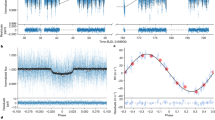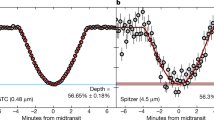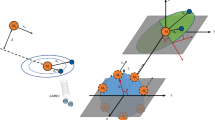Abstract
THERE are three distinct types of object in the Solar System—the Sun is a star ; the terrestrial planets (Mercury, Venus, Earth/Moon, Mars) are solid bodies ; and the Jovian planets (Jupiter, Saturn, Uranus, Neptune) are cold gaseous bodies. The nature of Pluto is not established and Pluto will be discounted for my purposes here. It is surely no accident that the solid members of the planetary system lie nearer the Sun than the gaseous members. The most distant terrestrial planet (Mars) is 1.52 AU from the Sun whereas the nearest Jovian planet (Jupiter) is 5.20 AU from the Sun (1 AU = 1.496 × 108 km). As yet no agreed view of planetary formation exists. Most theories involve a single process for all the planets (see, for example, ref. 1). I suggest that the division of the planetary bodies into solid and gaseous types may imply different formation mechanisms. In particular I suggest that the terrestrial planets formed in a high density shell surrounding the proto-Sun and that the Jovian planets are the remnants of other attempts to form stars contemporaneously with the Sun.
This is a preview of subscription content, access via your institution
Access options
Subscribe to this journal
Receive 51 print issues and online access
$199.00 per year
only $3.90 per issue
Buy this article
- Purchase on Springer Link
- Instant access to full article PDF
Prices may be subject to local taxes which are calculated during checkout
Similar content being viewed by others
References
Williams, I. P., and Cremin, A. W., Q. Jl R. astr. Soc. 9, 40 (1968).
Disney, M. J., McNally, D., and Wright, A. E., Man. Not. R. astr. Soc. 146 123 (1969).
Hunter, J. H., jun., Mon. Not. R. astr. Soc., 142, 473 (1969).
Larson, R. B., Mon. Not. R. astr. Soc., 145, 271 (1969).
Penston, M. V., Mon. Not. R. astr. Soc., 145, 457 (1969).
McNally, D., Proc. Albany Conf. Interstellar Dust and Related Topics (in the press)
McNally, D., Adv. atom. molec. Phys., 8, 1 (1973).
Allen, C. W., Astrophysical Quantities (Athlone Press, London, 1963).
Lin, C. C., Mestel, L., and Shu, F. H., Astrophys. J., 142, 1431 (1965).
Author information
Authors and Affiliations
Rights and permissions
About this article
Cite this article
MCNALLY, D. Are the Jovian Planets “Failed” Stars?. Nature 244, 424–426 (1973). https://doi.org/10.1038/244424a0
Received:
Issue Date:
DOI: https://doi.org/10.1038/244424a0
Comments
By submitting a comment you agree to abide by our Terms and Community Guidelines. If you find something abusive or that does not comply with our terms or guidelines please flag it as inappropriate.



